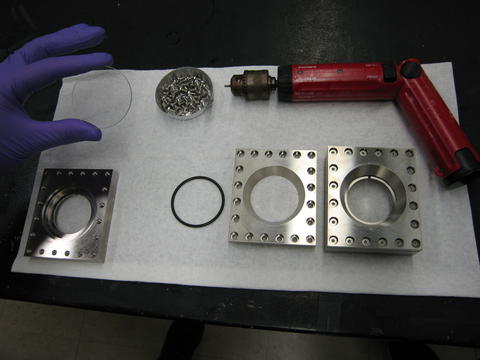NSE sample environment
NCNR offers the possibility to use many different sample environment apparati to control, just to name a few examples, the temperature, pressure, humidity,..., of your experiment. Not all of these equipment are available for use on NSE. In fact, some are just too big to fit in the sample area and others might have magnetic characteristics which severely disrupt the magnetic fields of the instrument. In this page, the sample environment apparati most commonly employed on NSE are listed for your reference. If you would like to use an equipment not mentioned in this page, whether it is already in use at NCNR or not, please contact one of the NSE instrument scientist to discuss the feasibility of its use.
Circulating Bath
The circulating bath is the equipment most commonly used on NSE to control the sample temperature. Temperatures from 5 °C to 150 °C can be achieved with an accuracy of 0.1 °C using a circulating bath filled with silicon oil. The circulating bath is used in conjunction with the demountable titanium cells.
Demountable titanium cells
The demountable titanium cells are our most used cells. They are easy to assemble, disassemble and clean and are able to hold gel, melt, powder and liquid samples. The cells have set sample path lengths of 1 mm, 2 mm, and 4 mm. The internal diameter of the cells is 4.0 cm, therefore, for example, the 1 mm path length cells require a sample volume of ≈1.3 ml. The sample is held in the cell by two quartz windows, each window sealed by a rubber o-ring (polytetrafluoroethene (PTFE) coated o-rings are available for those cases in which the sample could attack the o-ring). The o-rings are compressed by retaining rings that are screwed down in place. After assembling the cells, liquid samples can be inserted through the top using a syringe.

Picture of the demountable titanium cell apparatus. On the left you can see the main body of the cell. Above it an instrument scientist is holding the a thin quartz window. On the table there are also an o-ring and a titanium holder plate. Quartz window, o-ring, and holder have to be inserted in the main body of the cell in this order. Electric screw drivers (top-right of the picture) are available for assembling the cell.
Closed Cycle Refrigerator
NSE is equipped with a top loading Closed Cycle Refrigerator (CCR) which can be operated either in the low (temperature range from 4 K to 325 K) or high (temperature range from 50 K to 700 K) temperature mode. Also bottom loading CCRs are available for use on NSE, e.g. low temperature, general use, and high temperature closed cycle refrigerator. All together a temperature range from 5 K to 600 K is available.
Primarily, cylindrical aluminum cans are employed when using the CCRs.
Liquid Helium Cryostats
Liquid helium cryostats allow the study of your sample in the temperature range from 1.5 K to 300 K. Only the 50 mm cryostat will fit on NSE.
CHRNS-NSE
Contacts
-
(301) 975-5254
-
(301) 975-5505

